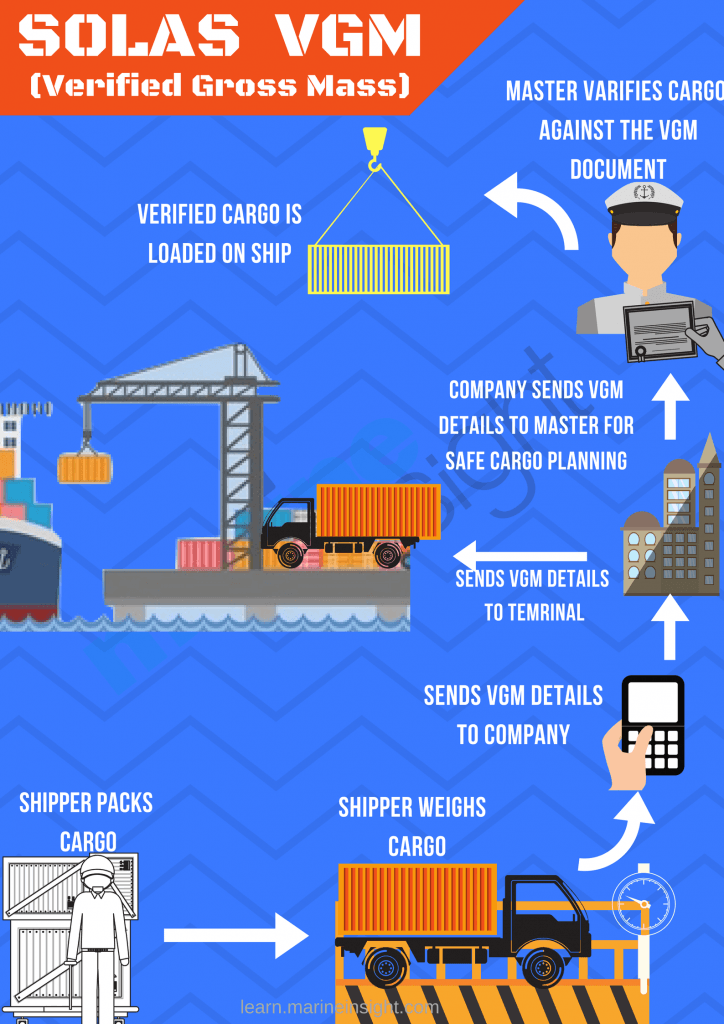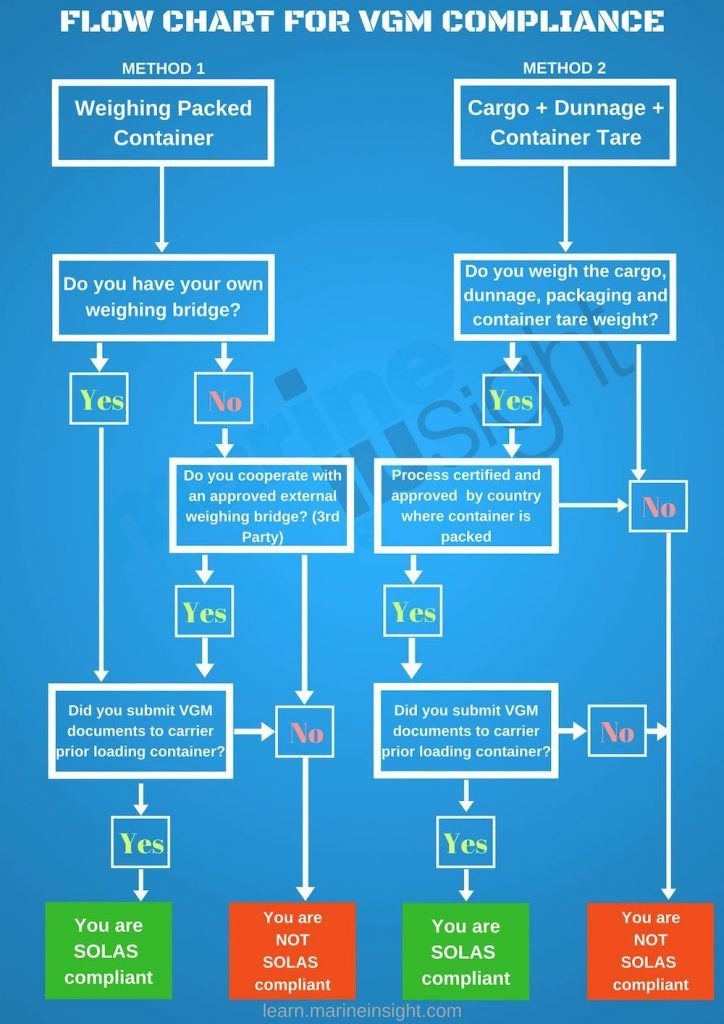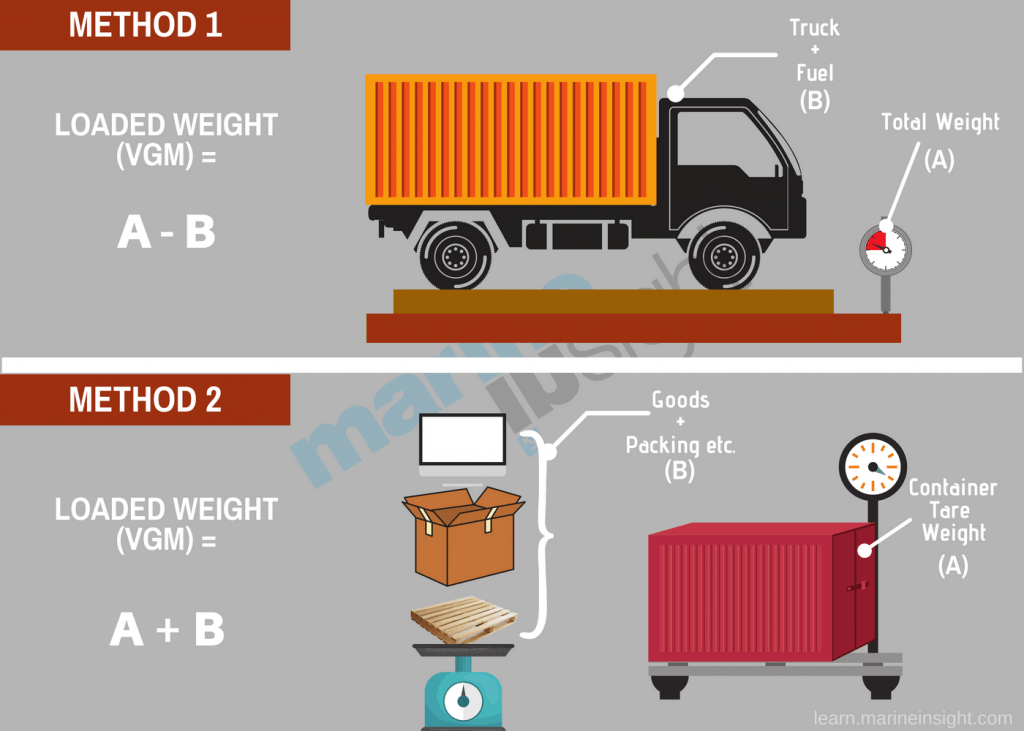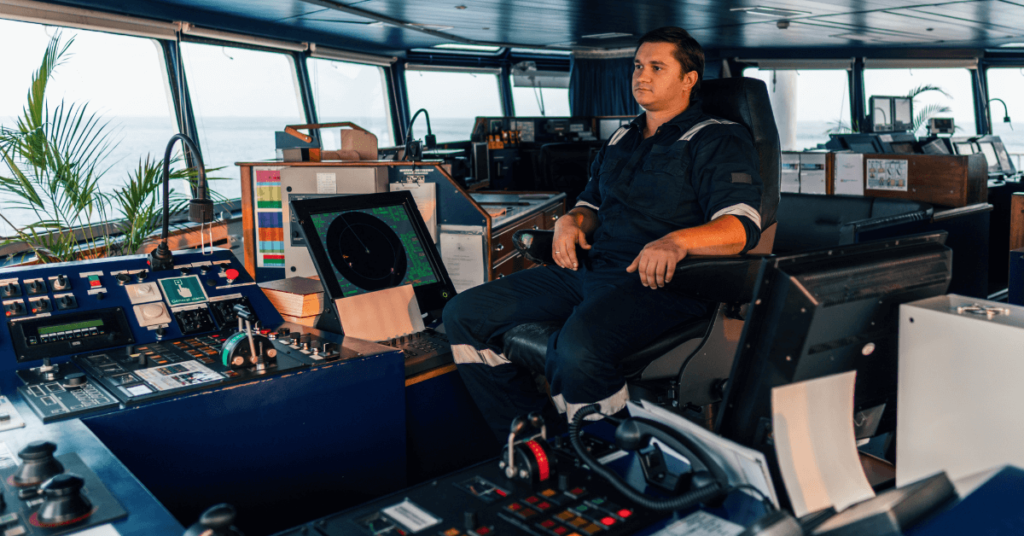A Guide To Verified Gross Mass (VGM) For Shipping
The Verified Gross Mass (VGM) is a fairly new concept introduced in the maritime industry. Container weight verification has now become a global requirement.
A new amendment was brought into force by IMO and introduced in SOLAS (Safety Of Life At Sea) regulation VI/2, adopted by resolution MSC.380(94) which became effective on the 1st of July, 2016 that covers container weight regulations.
According to this new amendment, no container is allowed to be loaded on board the ship unless its Verified Gross Mass has been declared by the shipper to the shipboard personnel and/or to port representatives.
This has been a great initiative by the IMO. The implementation of this rule has helped to improve the safety of ships at sea and benefit shipboard personnel as well as personnel ashore involved in container handling.
Related Read: Handling Containers On Ships: Dimensions, Markings and Bay Plan
What is VGM?
The Verified Gross Mass or VGM is the combined weight of the container tare weight and weight of all cargo, including all packaging and dunnage.
There are two ways of for defining the VGM: by weighing the packed container or by calculation. I will discuss both of these methods later in this article.
Now the question is why was this regulation introduced at all? What was the need? After all, until 2016, containers were loaded onboard ships without any such weight declaration.
Any query regarding the weight of the container could be found from the container markings which includes the Tare Weight and M.G.W (Maximum Operating Gross Weight).
Incorrect weight declarations have resulted in many accidents in the past. Incorrect weight declaration compromises the safe carriage of containers at sea and can put the life of seafarers at risk.
Accurate weight declaration is therefore needed to prevent injuries to life and assets.

Related Read: How to Plan Cargo Containers Stowage on Container Ship?
The shipper, whose name is mentioned in the Bill of Lading, is responsible to provide the VGM of the packed container to the ship personnel and the port terminals well in advance.
VGM is not shown in the Bill of lading. It is declared separately from the Gross Cargo weight entered in the Bill of Lading.
It is a violation against SOLAS to load a packed container on board a vessel whose VGM is undeclared. In the event of failure to declare the VGM of containers to be loaded onboard ships, the vessel can be delayed or cargo can be cancelled causing potential loss to the shipper as well as the carrier.
The container would be rejected at the port terminals which follow the “NO VGM – NO GATE IN” policy and additional charges will be incurred for the time spent outside the terminal awaiting submission of VGM. Penalties may be incurred for non-compliance by SOLAS enforcing authorities.
The VGM requirement was brought by IMO with the intention to improve and increase the safety of container vessels, improve vessel stability and prevent the collapsing of container stacks.
A lot of money is involved in the entire container transportation operation. Besides money, the most important factor is Safety which cannot be compromised at any cost.
Nowadays we have all seen that very many ultra-large container carriers have been introduced by different owners. With the increasing size of container carriers, comes an increased danger pertaining to the safe carriage of containers.
It is therefore very important to plan the stowage very accurately and keep stability criteria within permissible limits for a safe and sound voyage.
Any miscalculation or misinterpretation of data while planning the stowage and vessel stability can have disastrous effects in the long run. This is where the declaration of VGM becomes effective and crucial. The VGM requirement aims to reduce such risks.
Flowchart Showing Methods Of Determining VGM

Accepted Methods Of Weighing To Obtain The VGM
There are 2 methods to obtain the VGM as discussed below:
Method 1:
This method implies weighing of the packed/sealed container along with its cargo contents using calibrated and certified weighing bridge equipment. The certified weighing station can either be located at port terminals or outside ports.
If the container is weighed along with the road vehicle (chassis, truck) on which it is loaded, in this case, the weight of the truck and its fuel should be eliminated from the total weight.
Method 2:
This method requires weighing all the cargo items and contents of the container including the packing material, securing equipment, pallets or dunnage individually and adding those weights to the container’s tare weight as shown on the container CSC plate. Therefore the 4 elements to be determined to obtain VGM under Method 2 are:
- the tare weight of the container
- the weight of the product without any packaging.
- the mass of primary packaging (if any), and
- the mass of all other packaging, pallets, dunnage, space fillers and securing material
It should be noted that the weighing equipment (weighing bridge, scale or lifting equipment) used in either of the methods must meet the local country regulations and standards for accuracy certification and calibration requirements.
Estimating weight, in either case, is not permitted.
Proof of the weighing system used for certification must be made available on request which includes the following information:
- Weighing scale’s approval number
- Name of weighing scale company
- Date of weighing
- Address of weighing company
- Container number
- Seal number
- Name and signature of the weighing scale operating staff
- Company stamp

Related Read: What is the Container Security Initiative (CSI) and how does it Work?
Details To Be On All VGM instructions
- Booking or Bill of Lading number
- Container number
- VGM + unit
- Responsible party Name in full
- Legible Signature
- Place and date of signature
The verified gross mass obtained by the shipper may not be 100% accurate. Keeping in mind the fact that due to wear and tear, some container’s tare mass may change over time and vary somewhat from the tare weight as marked on the container door CSC plate; some countries have stated a 2-5 % tolerance for the VGM.
Some cargo products also may incur normal and minor changes in mass from the time of packing and weighing until delivery due to evaporation or humidity changes.
These margins of error are minor and will not possess any threat to the safety of the ship. However, this does not relieve the shipper from the obligation of using weighing equipment that complies with the accuracy standards of the jurisdiction in which the equipment is being used.
Below are examples of VGM declaration forms:
VGM Declaration Form

The shipper declares that the determination of the weight of the cargo container contained in the document is true and correct and in accordance with SOLAS regulations Article VI 2.4.2. A typical VGM DECLARATION FORM will include the following information:
- VGM declared
- VGM Weighing Method
- VGM Reference number
- VGM Signing person




VGM Report Stating The Weighing Method Used And The Gross Weight

Role of Ship Master
The ship captain plays a vital role in ensuring the packaged cargo loaded in her/his ship is VGM compliant to avoid any stability related issues which may lead to capsize or sinking of the ship. Following are the important duties of Master related to Verified Gross Mass of the Cargo:
- It is the responsibility of the ship’s Master to ensure that only packed cargo with VGM documentation is on board the ship
- The Captain and the shipping company manager should ensure that VGM of the packaged cargo is communicated in the shipping documents sufficiently in advance to be used in the preparation of the ship stowage plan. However, the responsibility for obtaining and documenting the verified gross mass of a packed cargo lies with the shipper. Usually, the shipping company will have a deadline infant of the shipper to produce the VGM of the packaged goods to ensure the ship has enough time for safely planning the cargo stowage
- As there is no standard document for showing the VGM of the cargo, the Master must ensure the document declaring the verified gross mass of the packed container should be signed by the shipper or by the person duly authorised by the shipper
- It is possible that the terminal or the ship may receive a packaged cargo/container with missing VGM. Such a container should not be loaded onto the ship until its verified gross mass has been obtained. To allow the onward movement of such cargoes, the Master or his representative and the terminal representative may obtain the verified gross mass of the packed container on behalf of the shipper by weighing the packed container in the terminal or elsewhere if only agreed by commercial parties. The ultimate decision will be with the ship’s Master weather to load such container or not once the VGM is determined
- It may happen that the packaged cargo have a VGM exceeding the permitted gross mass as specified in CSC. Such cargo/container may not be loaded onboard
- Master should ensure that the loading plan software onboard ship considers the VGM of the cargo
- VGM records to be maintained till the end of the voyage but for a minimum period of 3 month
Packaged cargo/ containers on the following form may be exempted from VGM:
- Containers carried on ro-ro ships on short international voyages if these containers are only transported on/off the vessel on chassis or trailers (Annex, page 3, 3.2)
- Offshore containers that do not need to apply to the International Convention for Safe Containers (CSC)
Related Read: 16 Types of Container Units and Designs for Shipping Cargo
VGM indicates the gross weight of the container with its content. The importance of VGM in shipping cannot be overlooked or bypassed. All member countries of the IMO have to implement and follow the VGM rules and requirements. The weight declared as VGM is Solas compliant, thereby eliminates any hidden or extra weight.
The vessel should use verified weights for all loaded containers to calculate final stowage and loading plans. This will result in better and improved stability calculations of the ship and reduce potential risks to safe navigation which may have otherwise occurred due to undeclared weights and incorrect stability calculations.
Not only this, but it will also prevent cargo claims and structural damages to the vessel.
Availability of the verified gross mass of a packed container to the Master of the ship on which it is to be loaded is, therefore, a prerequisite. It is true that by simply just declaring the VGM, all the risks related to the safe carriage of containers cannot be abolished.
Improper load distribution and poor securing and lashing are also major contributors to risks and accidents faced by container ships at sea.
However, encouraging the accurate declaration of the weight of the containers loaded on board ships will improve the safety of the vessel and mitigate risks to some extent. We must take all the possible steps positively that concerns the safety of the ship and the environment.
You Might Also Like To Read:
- Laws Of Salvage: 10 Things You Must Know
- Flat Rack Containers: Types, Specifications And Dimensions
- What Are Insulated Shipping Containers?
- What Are Open Top Containers: Design, Specifications and Dimensions
- Container Seals: Importance, Types, And Requirements
Disclaimer: The authors’ views expressed in this article do not necessarily reflect the views of Marine Insight. Data and charts, if used, in the article have been sourced from available information and have not been authenticated by any statutory authority. The author and Marine Insight do not claim it to be accurate nor accept any responsibility for the same. The views constitute only the opinions and do not constitute any guidelines or recommendation on any course of action to be followed by the reader.
The article or images cannot be reproduced, copied, shared or used in any form without the permission of the author and Marine Insight.
Do you have info to share with us ? Suggest a correction
Latest Shipboard Guidelines Articles You Would Like:

About Author
Paromita has completed graduation in Nautical Science and is presently preparing for 2nd mate exams. Besides sailing, she loves to read books and travel. She has also won many awards in music.
Subscribe To Our Newsletters
By subscribing, you agree to our Privacy Policy and may receive occasional deal communications; you can unsubscribe anytime.

















Very informative article, thanks for it. Please can you answer this for me.
Shipper is responsible to verify the gross mass of the container, but who actually checks the container and sign that the container mass has been verified? In case of wrong declaration of gross mass apart from shipper who all will be responsible??
@Anirudh- A packed container must be weighed prior to loading the vessel. If the actual gross mass of the container weight is not verified and submitted to the terminal prior to vessel loading, it will not be loaded or at least flagged as “unsafe.”
IN reality, No One is checking the weights against the provided VGM.
No Captain will be able to check the VGM declarations and has to rely on the weights received from the terminal.
Immagine how long it will take to check the documents prior loading of lets say 2000 boxes before the vessel can start loading. Which charterer will accept to keep gangs idle for checking additional documents?
Here we need to trust the terminal that they have checked the VGM or that the shipper made a correct declaration and that the correct weight is used in the EDI file sent on board.
What is the standard VGM weight for a Export 20 GP if I were to ship it out from PNG to China?
Most carriers/terminals off the USWC submit VGM based on the actual weight of the cntr scaled at the time of return to the In-land POR and/or the POL.
Tanks for good and helpful information
Is there a maximum weight on vgm?
According to the International Convention for Safe Containers (CSC), the maximum weight of a container cannot exceed the maximum payload specified on the plates attached to the container.